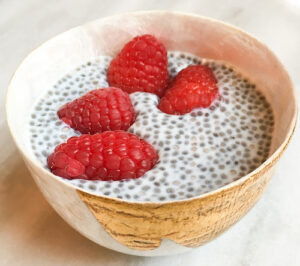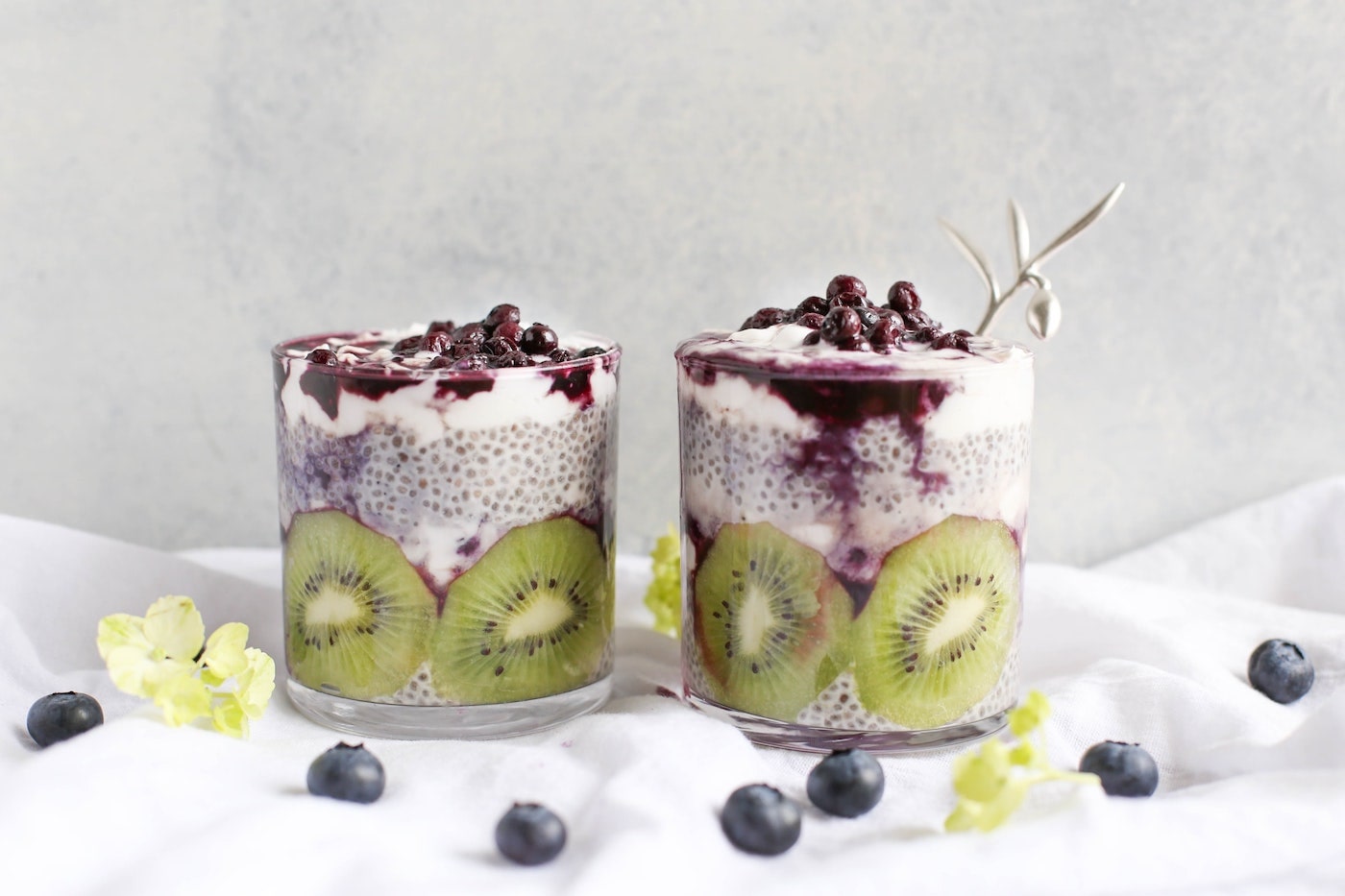Getting enough fiber on your plate can be quite the challenge, even before starting your FODMAP journey. So what about when you’re in the thick of it? Unfortunately, reducing FODMAPs oftentimes means reducing many high fiber food options. And though powdered supplements may help, some doctors caution against their long-term use and recommend food sources instead.
So what if someone told you of an all-natural dietary fiber source that’s affordable, low calorie, easy to find and use, versatile, gentle but effective, and really fun to say? That’s right. We’re talking about chia seeds, the very same kind used for those infamous terra-cotta Chia Pets advertised on TV. Incorporating chia seeds into your low FODMAP diet not only gives you a boost of antioxidants and minerals, but it might also help with IBS symptoms related to low fiber. A close examination of the seeds’ impressive nutritional properties might have you running out to buy a bag of these tiny powerhouses right away!
What are the benefits of chia seeds?
Health food enthusiasts picked up on chia’s health benefits in the 1970s, but the Aztecs were the first known to use these nutritious seeds — they referred to chia as “strength from the ground” and consumed it for sustenance on long journeys. Modern researchers have found evidence that chia supports healthy blood lipid profiles and might even promote weight loss and healthy blood sugar levels.
Chia comes from a desert plant, salvia hispanica, which is a member of the mint family. There’s nothing minty about the way it tastes, however, and most people don’t find a taste at all. Besides fiber (10 grams per ounce), chia seeds contain omega-3 fatty acids, calcium, potassium, folate, essential amino acids, and antioxidants.
Chia as a low FODMAP fiber source
Studies on chia’s dietary fiber benefits are scarce, but research in 2016 by a British university compared three natural fiber sources — chia, psyllium husk, and flaxseed — in a two-week experiment on satiety and bowel function. In the study, 18 people were randomly divided into three groups. Each group received just one of the three fiber sources to consume in five gram (about one-fifth of a tablespoon) amounts during breakfast each day for seven days. The groups then completed a questionnaire that helped them evaluate the effect. The results? Chia and psyllium husk had a significantly positive (and pretty much equal) effect on bowel function and satiety, surpassing the flaxseed group.
As sources of soluble fiber, chia and psyllium have another thing in common — both collect water and expand a little when going through your digestive system. You can observe this gelatinous texture by adding a little water to a few chia seeds — within minutes, they’re surrounded by a clear gel. Some might say to use psyllium or chia, but don’t forget that chia offers nutrients you won’t get with psyllium and comes in many more forms. Along with chia seeds, you can buy chia flour, chia oil, chia capsules, tinctures, and even chia health drinks. According to Monash University, most people with IBS can tolerate about two tablespoons per day. However, it’s a good idea to introduce the seeds into your diet in very small quantities at first.
7 chia seed recipes we love
Before getting started, note that you should always use your chia with moist ingredients and never consume dry chia seeds. Doing so could cause the seeds to lodge in your esophagus. Moistened chia seeds, known as chia gel, are another option.
Ready to do the chia? Here are a few recipe ideas for starters:
Chia pudding

A favorite way to use chia is in a decadent low FODMAP pudding (check out Rachel Paul’s recipe). Once made, set out a few small Mason jars, sprinkling a thin layer of chia seeds at the bottom of each. Spoon in your pudding, leaving about an inch at the top. Refrigerate overnight and, in the morning, you’ll see chia bubbles where the seeds expanded at the bottom.
Chia yogurt
Take your favorite low FODMAP yogurt and sprinkle a half-teaspoon on top every time you dig in. Nutrition research in 2019 showed that yogurt with chia is healthier than without.
Salad dressing
There are many chia salad dressings around, but you can make your own low FODMAP version with olive oil, vinegar, mustard, and herbs. Add a proportionate amount of chia at the end and shake well, refrigerating overnight. Don’t want to make dressing? Just sprinkle chia seeds over your salad anyway!
Chia smoothies
You can make smoothies of all kinds with chia using your favorite low FODMAP milk or yogurt, fresh fruit, and your preferred ingredients. Use a strong blender for mixing; otherwise, the seeds can get stuck in your straw or drop to the bottom. No thanks!
Chia in baked goods
Breakfast is the best time to get your chia in, so mix a teaspoon or so of seeds or powder into low FODMAP your waffle or pancake mix. Stir well and cook as usual. You’ll enjoy the way the seeds show through and remind you of how much great fiber you’re getting! Don’t forget you can use small portions of chia powder as well for your own baked goods like muffins and scones.
Chia for salt lovers
Chia goes with savory flavors as well as sweet, so sprinkle a teaspoon over a cup of cottage cheese. If your diet doesn’t allow dairy, try it instead over scrambled eggs, egg substitutes, or in soups. You can even put it on rice or mashed potatoes – so versatile!
Chia toast
Atop your favorite low FODMAP bread, spread some jam over toast and sprinkle chia on top. For another take on eating chia seeds, use 1/8 of an avocado instead of jam and fist-pump for all the omega-3 fatty acids you’re getting.
Buying and storing chia
Chia can last for up to two years when stored in a cool, dry place. For daily use, you can put it in a parmesan shaker or spice jar. Use a small spoon or your clean fingers to sprinkle the seeds onto dishes. You can buy chia seeds at most health food stores, regular supermarkets, and online.
Once you get on board with this ancient health food, you’ll be taking some with you for meals on the go. Remember that only your doctor can provide medical advice, so be sure to check with your practitioner before consuming chia seeds for increased fiber intake.
What’s your favorite way to use chia seeds? Let us know in the comments below!
xvideos,
Brazzer,
xhamster,
xvideos,
hentai,
xxx,
Phim sex,
tiktok download,
Anime xxx,
,
Free MP3,
,
Mark Sanchez Stats,

I love how you highlighted the versatility of chia seeds in a low FODMAP diet! I’ve started incorporating them into my smoothies and overnight oats, and the added fiber really makes a difference. Thanks for the tips on how to enjoy them!
I loved this post! Chia seeds have become a staple in my diet since I started following a low FODMAP plan. It’s amazing how versatile they are, and I appreciate all the creative ideas you shared for incorporating them into meals. Can’t wait to try the chia pudding recipe!
I never realized how versatile chia seeds could be for a low FODMAP diet! I’m excited to try out some of these recipe ideas. Thanks for sharing such helpful information!